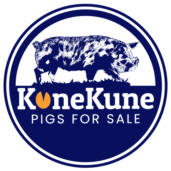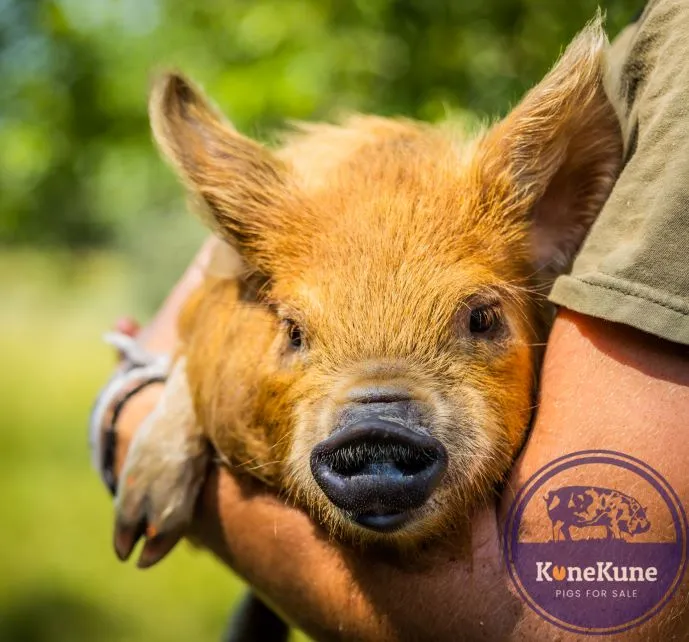When considering breeding KuneKune pigs, it is important to understand key details about what sets them apart from other hog breeds, reasons for breeding them, how many you need to get started, best practices for mating and gestation management, farrowing preparation, and caring for sows and piglets post-breeding. This overview will specifically break down distinguishing traits, reasons for breeding, herd size guidance, mating and gestation considerations, farrowing preparations, and post-natal care recommendations. By outlining essential learnings across these breeder topics first, new KuneKune owners can set themselves up for success raising happy, healthy pigs.
What Distinguishes KuneKune Pigs as a Breed for Pig Breeders?
Kune Kune Pigs (pronounced Cooney Cooney) originated from New Zealand, first introduced in the early 1900s. As a breed, they have several unique traits for those interested in breeding them such as heritage appearance, size, temperament, and low-maintenance care needs that set them apart when compared to modern commercial hogs. In our experience they are a great solution for first time pig farmers due to their low input requirements, temperament and much more.
Origin of Kune Kune Pigs and Their Unique Traits
KuneKune pigs have a rich history of their origins and roots with multiple theories of where they originated from. However they were first recognized and documented by original New Zealand settlers, the KuneKune breed stabilized in the 1970s into the gentle medium-sized grazing pigs prized by farmers today seeking homegrown pork and preservation of traditional livestock. For the first 40 years they were on the endangered species list up until 2010.
As heritage lard-type pigs, common physical attributes include a thick reddish brown or black hairy coat covering a distinct rounded silhouette. Depending on specific bloodlines, average weights at maturity span 120-240lbs.
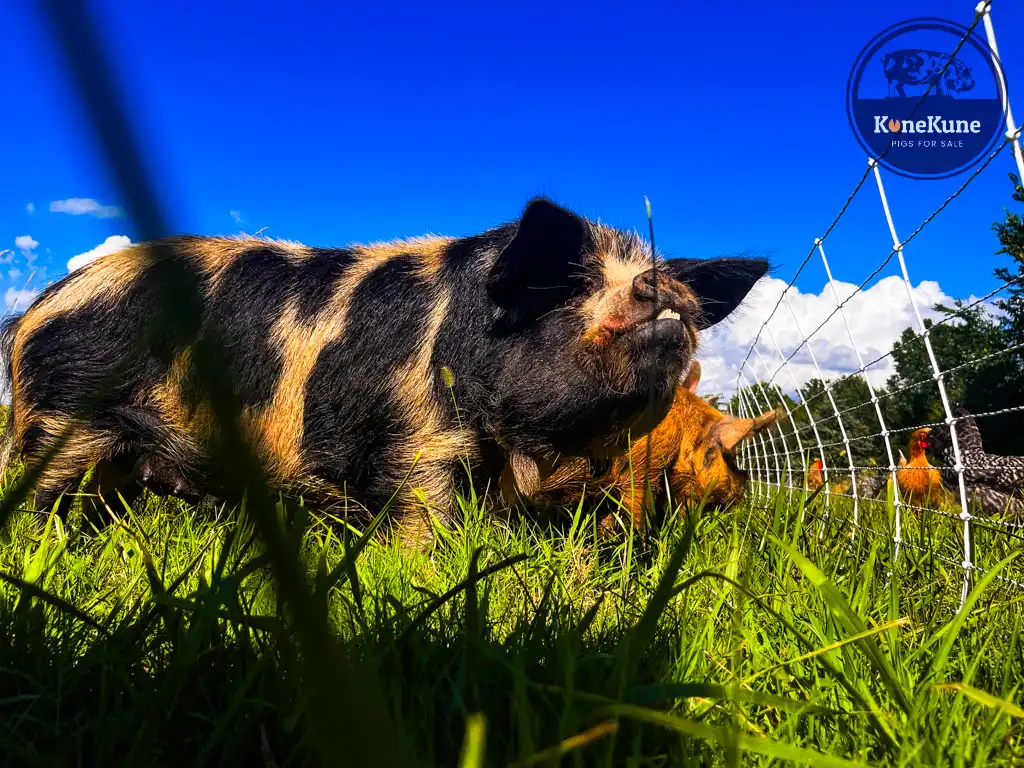
Unlike the integrated lean commercial industry focused purely on meat production efficiency, KuneKunes deliver versatile utility: from grass-fed pork, lard for bakeries and soap makers to docile temperaments that endear them as pasture pets.
KuneKune Pig Behavioral Characteristics
In addition to physical heritage attributes, KuneKunes display some behavioural traits that enable their niche roles, but also require consideration:
As intelligent social herd animals, they live in stable groups of 4-6 once matured with an established pecking order hierarchy. This integration from piglet stage allows self-sufficient foraging behaviors ingrained by the sow to translate to the grown herd.
KuneKunes use a diverse range of vocalizations including unique “kune kune” sounds for communicating between herd members signalling hunger, dominance or location among seasonal forest plots.
With sturdy snouts and foraging drive, their rooting and digging instincts sustain them grazing fields and forest, but require space and stimulation in confinement compared to less hardy breeds accustomed to concentration.
Why Consider Breeding KuneKune Pigs?
KuneKune Pigs offer some compelling reasons as a hardy heritage breed that make them worth exploring for small scale breeders seeking alternative roles:
Importance of Sustainable KuneKune Breeding Practice?
As grazing pigs that survive by foraging grass, shrubs and mast, KuneKunes align well with stewarded land principles allowing pasture rest and rotational grazing critical for holistic farming.

They are disease resistant, excellent feed conversion of variable forage and smaller size that delights direct-to-consumer farm stands make them attractive for homesteaders seeking a regenerative lard or meat production with fewer expensive inputs than most pigs require.
What are the Potential Rewards and Challenges of Breeding KuneKunes?
In addition to environmental sustainability factors that bring people to the breed, part of the appeal lies in personality and novelty for small farmers who value that connection.
- Friendly pigs that make endearing 4H project animals for children offer an alternative to confined pigs lacking enrichment. Direct relationships between caring herdsman and trusting herd is part of the attraction for those focused more on pet feeders than maximum production.
- Markets for specialty heritage pork like KuneKunes shows promise, but ensuring a consistent supply pipeline of quality breeders takes time and networking. Aligning with local chefs or salumists rewards patience, relationships and filling niche gaps between commodity pork and bespoke exclusives.
How Many KuneKune Pigs Are Needed to Start Breeding?
You need a minimum of 2-4 KuneKune Pigs to start a breeding herd for Genetic Diversity. We always recommend starting with at least 4: both a boar and gilt pairing, along with a barrow companion for each one during isolation.
Herd numbers depend on yearly production goals for pork or feeders, space constraints if grazing marginal land, and budget for twice annual farrow management. Make sure to review genetic coefficients when sourcing founding pairs from established local KuneKune bloodlines to minimize unwanted inbreeding traits over generations.
What is COI?
In KuneKune Pigs COI (Coefficient of Inbreeding) measures how genetically close two KuneKune pigs are to each other. It is the probability that a pig receives two identical copies of the same gene from an ancestor shared by its parents. A Higher COI percentage (%) indicates the parents are more genetically related.

KuneKune Health and Genetics Considerations
When sourcing your founding breeding pairs or trio groupings, prioritize health and diversity right away to avoid perpetuating issues over generations:
- Seek unrelated stock from experienced regional breeders with insights on KuneKune bloodlines and purity. Review lineage records for any prevailing conditions.
- Visually confirm quality indicators like fertility, sound structure and temperament suitability in pigs before acquiring.
- Ensure you have your Pigs evaluated by a vet. Schedule antibody or virus testing for baselines helpful monitoring threats long term across the herd in your area and climate.
Evaluating Kune Kune Conformation and Temperament
While some preference exists between breeders, characteristics generally sought when selecting breeding candidates include:
- Size –
- Adult Boars: Generally range from 200-240 lbs (90.72-108.86 kg), though some males may reach 400 lbs (181.43 kg)
- Adult Sows: On average Female (Sows) KuneKune Pigs typically weigh 120 – 200 lbs (54.43 kg – 90.72 kg).
- Body – Rounded torso with straight back; 10-15 body lengths. Good spring of rib without sloping rump.
- Legs – Set squarely under body supporting sturdy stance. Moderate pastern length enables extensive grazing.
- Head – Broad skull tapering to rounded snout without respiratory issues. Friendly alert expression.
- Coat – Thick and coarse protecting skin with either reddish brown or black accepted colors per breed standards.
- Temperament – Innately docile and laidback nature biddable to handling. Moderate curiosity and foraging drive.
Picking physically sound KuneKunes with calm dispositions improves the probability of breeding program success. Personally observe and handle prospects before purchasing.
When is a KuneKune Sexually Mature?
Female KuneKune Pigs reach breeding age (sexual maturity) as early as 10 months of age. Male KuneKune Pigs reach sexual maturity around 1 year old. It is a best practice however to plan to wait on breeding any gilts until about 12-15 months minimally for a successful farrowing. This is due to early breeding complications and issues that arise in younger gilts.
How Many Piglets are in a KuneKune Pig Litter?
Average litter size ranges from 6 to 8 piglets for KuneKune Pigs. First time Sows may birth up to 12 piglets initially before litter counts stabilize over later gestations. Litters under 3 occur rarely, as sows tend to reabsorb tiny sets then restart cycles aiming for viable numbers long-term.

Understanding the KuneKune Breeding Process
Knowing what to expect when your KuneKune boar and gilt or sow are mated improves odds for breeding success:
KuneKune Mating Dynamics and Methods
KuneKunes generally breed naturally once sexually mature. Some tips:
- Fence Line Exposure – Allowing nose-to-nose interaction when a female enters estrus can enable pairs to become more comfortable before mating.
- Male Competition – Introducing another unfamiliar boar during peak estrus can spark hesitation in untested young boars. However yard fights risk injury so limit interactions.
- AI Allows Options – Artificial breeding opens genetic diversity found globally without ownership if desired. Certified technicians handle fresh or frozen semen collection, direct vaginal insemination and documentation for purebred registration eligibility.
Pay close attention to physical estrus signs and distinct behavioral changes when planning a breeding. Understand adolescent excitation needs patience avoiding accidental litters. Review signs of successful mating later in this guide.
Caring for the Pregnant KuneKune Sow
Providing comfortable environments through the gestation fosters healthy litters. Focus on nutrition, socialization and tracking fetal development when expecting KuneKune piglets:
Gestation Period Length in KuneKune Pigs
The average KuneKune sow pregnancy lasts 116 days, slightly longer than commercial sows. For easy approximation, remember:
- 3 months, 3 weeks and 3 days
But farrowing can deviate across different litters so remain observant as due dates approach. If you already know the breeding dates or the penned dates we have developed a great tool for breeders to calculate farrowing dates for KuneKune Pigs.
Tracking Gestation Stages in KuneKune Pigs
Monitor for key indicators labor is nearing:
- Teat Enlargement – Swelling starts ~2 weeks pre-farrow
- Prominent Udder Veins – Signifies milk production around 2 weeks out
- Vulva Swelling -color changes – Up to 4 days prior
- Nesting Behaviors – 12-24 hours up to birthing
Recording initial dates for visible changes allows estimates of when delivery nears. But have preparations ready several days prior just in case.
Dietary Needs of the Pregnant KuneKune Sow
- Maintain normal feed levels through early gestation
- Increase portions 25-50% in third trimester to support litter growth
- Free feed grass/greens providing enough roughage Account for environmental temperatures and space needing additional calories maintaining healthy weight over winter months. Sows should not become overly fat or thin to avoid health impacts on both mother and offspring.
What Do You Need to Prepare for KuneKune Pig Farrowing?
Adequate arrangements for the birthing process reduce issues lost piglets and sow recovery. KuneKune Farrowing is a wonderful experience so long as you are prepared and ready for all of the curveballs that may be thrown your way.
Necessary Farrowing Preparations
- Clean, disinfect and bed farrowing hut 1-2 weeks prior
- Chopped straw bedding minimizes piglets hiding and digestion issues if eaten
- Safe zone heating for Fall/Winter litters protects against exposure and sow crush incidents
- Have clean towels, gloves, lube on hand to assist
- Install roll bars preventing accidental smothering events
Ensuring Safe KuneKune Farrowing
- Novice sows may panic seeing piglets initially.
- If extreme fear reactions emerge, carefully relocate litter allowing sow to overcome shock.
- Slow reintroduction once maternal drive activates keeping piglets fed during transition.
- Agitation persisting over 24 hours may require anti-anxiety prescription meds short term per vet advice.
Have backup contingency plans if emergencies like litter rejection arise. Locate area breeders willing to adopt surplus piglets or utilize foster sows. Swift action preserves viability minimizing stunting.
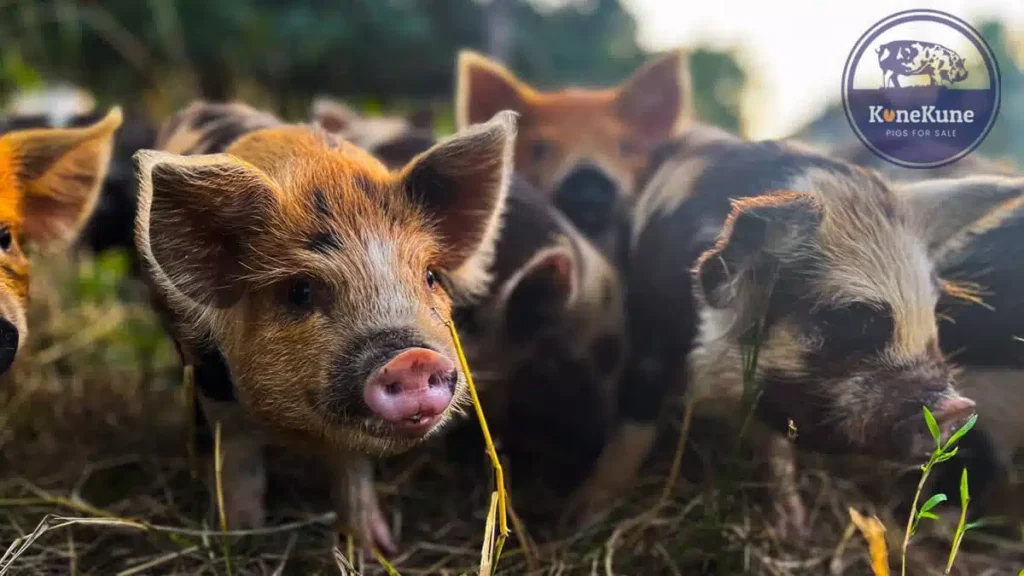
How do you Care for your Pigs Post Farrowing?
Proper oversight during neonatal development and transition back into the rotational herd system supports swine health:
Initial KuneKune Piglet Care and Health Checks
Early efforts focus on survival fundamentals:
- Weigh pigs marking lighter ones needing priority observation
- Check umbilical area healing absent infection
- Palpate stomachs ensuring feeding within hours after farrowing
- Assess functional teats for each new litter exceeding 10 piglets
- Provide supplemental heat until establishment of pile sleeping
Monitor twice daily as piglets mature tracking weight gain across individuals. Handling frequently gets them comfortable with inspection for prospective buyers.
KuneKune Piglet Feeding and Weaning Best Practices
- Piglet starter feed transitions from milk at 2-4 weeks old
- Introduce pasture/greens forage then adult ration pre-wean
- Average weaning age is 8-12 weeks pending sow rebreeding status
Weigh options like temporary foster rotation of larger legacy litters to support weaker runts of younger sows.
Encouraging Socialization in KuneKune Piglets
Begin positive regular human interaction early to minimize future handling issues. Piglets allowed to Integrate into herd dynamics from young age acclimate easier long-term over confined farrowing.
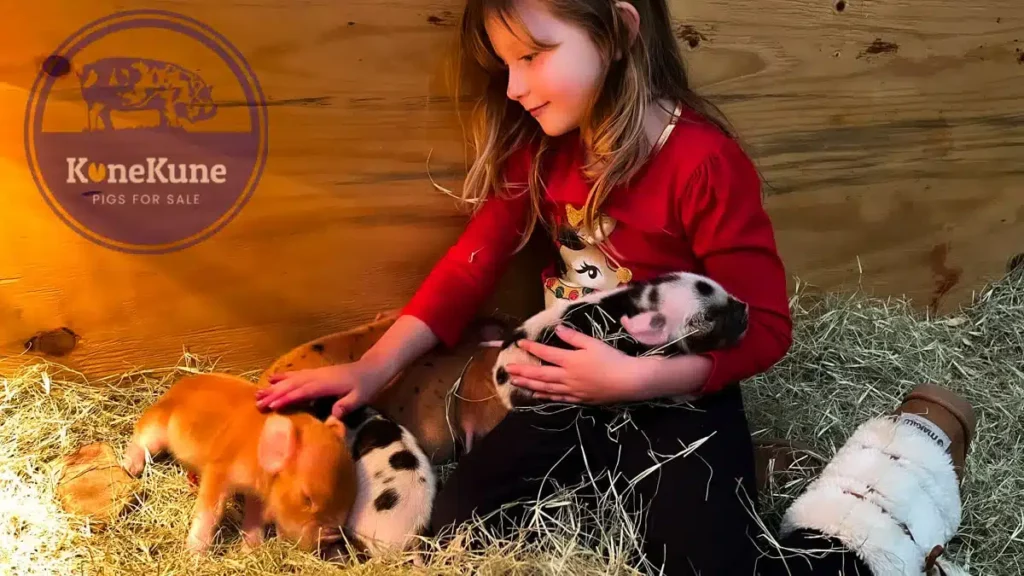
Reintroducing the Post-Wean Sow to Herd
When sow condition permits rapid rebreeding integrate back into herd before the litter would naturally wean. Slow reintegration tips:
- Temporarily remove overly aggressive dominant sows first
- Allow fence-line interactions but have backup enclosure if injuries occur
- Distract with food reducing squabble risks
- Watch for injuries possibly needing medical treatment
- Prepare to separate overly aggressive individuals until calmer
